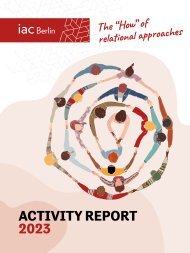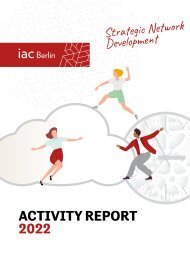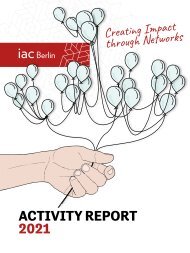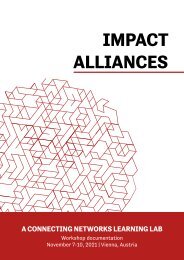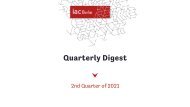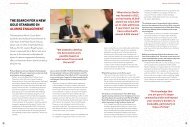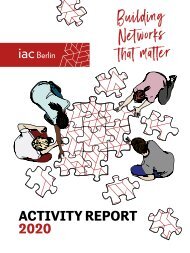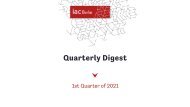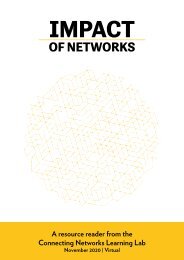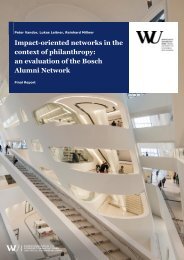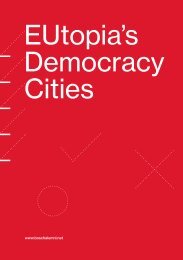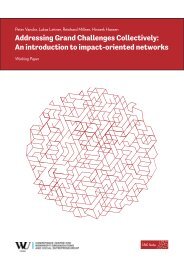Bosch Alumni Network - Driving Change
This publication provides an overview of the people, projects and topics within the network. It showcases its diversity and potentials and outlines opportunities to get involved.
This publication provides an overview of the people, projects and topics within the network. It showcases its diversity and potentials and outlines opportunities to get involved.
Create successful ePaper yourself
Turn your PDF publications into a flip-book with our unique Google optimized e-Paper software.
<strong>Network</strong> Density: Indicator of<br />
Important Players:<br />
Effectiveness and Stability<br />
Influencers and <strong>Network</strong>ers<br />
An entire network can be described through<br />
Social network analysis not only considers<br />
What is a cluster?<br />
one major indicator: its density.The density<br />
the entire network, but can likewise provide<br />
The <strong>Bosch</strong> <strong>Alumni</strong> <strong>Network</strong><br />
brings together alumni from<br />
over 160 programs of the<br />
Robert <strong>Bosch</strong> Stiftung.<br />
In order to connect alumni<br />
with similar profiles, the<br />
concept of topic-based<br />
clusters was developed.<br />
provides insight about the entirety of<br />
existing connections compared with the<br />
connections that are theoretically possible.<br />
<strong>Network</strong>s with particularly high levels of<br />
density possess greater effectiveness and<br />
stability.<br />
insight on particularly central and there fore<br />
important players (larger nodes). These<br />
are identified by the connections issuing<br />
from them (out-degree) and the connections<br />
going towards them (in-degree).<br />
People who are mentioned particularly<br />
often by others can be called influencers.<br />
The Governance<br />
Cluster in figures:<br />
Those who mention a high number of other<br />
people can be called networkers. In the<br />
structure of a network, these two groups of<br />
500+<br />
people are of particular signifi cance: they<br />
serve as multipliers and communicators<br />
into their network and are thus key points<br />
for spreading information, among other<br />
alumni<br />
things.<br />
have subscribed to the<br />
“Governance” group on<br />
boschalumni.net.<br />
36<br />
project ideas<br />
from alumni of<br />
20<br />
programs<br />
The alumni network of the<br />
were submitted to the first<br />
call for ideas announced<br />
within the Governance<br />
Cluster in fall 2017.<br />
1 hackathon<br />
about biodiversity<br />
1 listening lab about<br />
urban transformation<br />
“Bellevue Program.” The last two<br />
program cycles are depicted<br />
in light blue and pink. Their<br />
network is relatively dense, for<br />
instance, but is mainly limited<br />
to their own program cycle.<br />
1 podcast series and<br />
online symposium<br />
<strong>Network</strong> maps: between | . | ness<br />
about online learning<br />
1 virtual training for more<br />
citizen participation<br />
1 cross-sectoral workshop<br />
on the promotion of<br />
trust and transparency<br />
were organized by alumni<br />
for alumni in 2018.<br />
Navigation assistance for the<br />
network maps<br />
Behind every node of these graphics is<br />
a clearly identifiable person. Every line<br />
between two nodes represents a connection<br />
between two people. The colors<br />
stand for different program cycles.<br />
The influencers in the network<br />
of the “Robert <strong>Bosch</strong><br />
Foundation Fellowship<br />
Program.” The larger the<br />
nodes, the more often the<br />
person was mentioned<br />
by other alumni from the<br />
program.<br />
15




